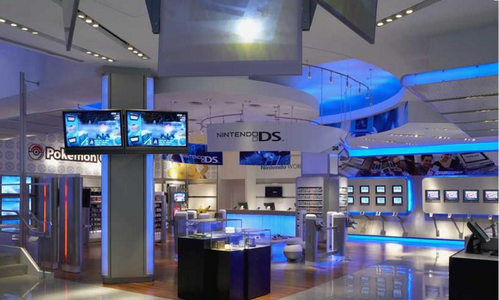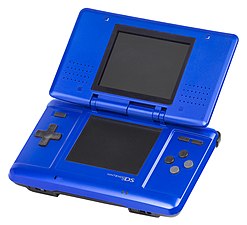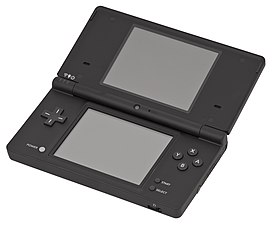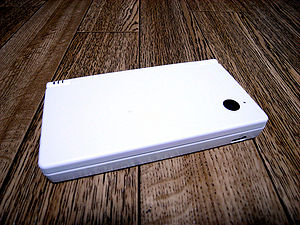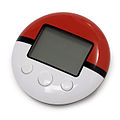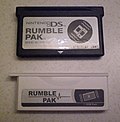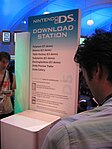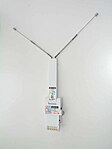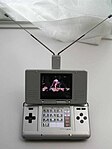History of video games/Platforms/Nintendo DS
-
An original model Nintendo DS.
History
[edit | edit source]
Development
[edit | edit source]The Nintendo DS was preceded by the Game Boy Advance line of consoles.
The decision to make a console with two screens came from a suggestion from former Nintendo president Hiroshi Yamauchi to then current Nintendo President Satoru Iwata, becoming project Nitro.[1]
Launch
[edit | edit source]November 21st, 2004 was the North American launch date for the DS, with a launch price of $149.99.[2]
The Nintendo DS Lite was launched in 2006.[3]
The Nintendo DSi was released in 2008 in Japan.[3]
Legacy
[edit | edit source]Many games on the DS made experimental use of it's touchscreen, paving the way for mobile experiences.[4] The DS was noted for it's strong third party developer support.[4] The DS sold 154.02 million units.[4][5]
The Nintendo DS was followed by the Nintendo 3DS and 2DS lines of consoles.
Atypical Usage
[edit | edit source]A single screen variant of the DS was made specifically to create Nintendo Zone access points at retail locations.[6]
In 2007 Nintendo released the Nintendo Fan Network, an app for the DS that allowed users to check stats and order food from their Safeco Field seats Mariners games.[7][8]
In 2010 McDonalds Japan spent 200 million yen (Roughly 2.2 million US dollars at the time) developing a training game for the Nintendo DS.[9][10][11]
Technology
[edit | edit source]
Compute
[edit | edit source]The DS is powered by an primary 32-bit ARM946E-S CPU clocked at 67 megahertz working with an 32-bit ARM7TDMI CPU clocked at 34 megahertz for backwards compatibility and IO management.[12] The DS has 4 megabytes of PSRAM and 656 kilobytes of VRAM.[12]
The DS has a traditional 2D engine and a somewhat unorthodox 3D engine.[12][13] This means that while the Nintendo DS was capable of 3D graphics, they were somewhat unwieldly on the system. This was compounded by a very different user interface, lacking an analog stick on the DS. However the Nintendo DS exceled at 2D graphics and was capable of rendering impressive 2D artstyles which would have been more difficult on previous Nintendo handhelds.
The Nintendo DS is capable of 600 megaflops of performance.[14] The Nintendo DS is often compared with the Nintendo 64 in terms of power, though to due to architectural differences and operational concerns, both tend to excel in different fields of computational tasks.
Hardware
[edit | edit source]The DS uses two 3.25" color TFT active matrix LCDs.[15]
An interesting quirk of the original DS involves its top screen, which is electromagnetically noisy enough to broadcast a usable signal to some older analog televisions, indicating an unusual signaling system for an LCD.[16] The Nintendo DS Lite, but not the previous original DS, included intentional built in TV out features, but this was never exposed to the user via hardware, and these features were disabled in official software - making the hardware an appendix of sorts.[17] The hardware was removed entirely in later DSi units.[17]
The DS supports 2.4 gigahertz Wi-Fi b but only supported the weak WEP encryption standard.[18][19] At launch this was relatively acceptable, as Wi-Fi was still a new technology, and many deployments were either unencrypted, or used weak WEP encryption, though this would rapidly change over the life of the system. The DSi added support for Wi-Fi b/g and more advanced encryption methods.[15][19]
The DS has a built in microphone,[18] an innovative addition at the time, which was leveraged by some games for gameplay purposes.
The DS uses a lithium ion battery as standard.[18] This was a convenient feature at the time, as it allowed recharging the system instead of replacing AA batteries. Previous Nintendo handheld lines, such as the GameBoy Advance, only included a rechargeable battery on some models, and some budget devices still relied on AA batteries, which reduced their upfront cost by making the consumer buy the batteries for the system, which often increased their long term cost.
The DSi has two 0.3 megapixel cameras: one facing the user, and one facing away from the user.[20]
The original DS has an included wrist strap accessory that includes a thumb stylus at the end.[21]
Software
[edit | edit source]A web browser cartridge based on the Opera browser was available for the DS Lite.[22]
The Nintendo DSi included support for DSiWare downloadable software.[23]
Notable Games
[edit | edit source]2004
[edit | edit source]Super Mario 64 DS
[edit | edit source]A launch title, and expanded remake of the Nintendo 64 game Super Mario 64.
Read more about Super Mario 64 DS on Wikipedia.
2005
[edit | edit source]Clubhouse Games
[edit | edit source]Read more about Clubhouse Games on Wikipedia.
Electroplankton
[edit | edit source]Read more about Electroplankton on Wikipedia.
Nintendogs
[edit | edit source]A pet simulation game.
Read more about Nintendogs on Wikipedia, or read the Nintendogs strategy guide on Wikibooks.
Advance Wars: Dual Strike
[edit | edit source]A continuation of Advance Wars, with added characters and features, primarily the ability to use two commanding officers simultaneously instead of one.
Read more about Advance Wars: Dual Strike on Wikipedia.
Phoenix Wright: Ace Attorney
[edit | edit source]A more popular enhanced port of the Game Boy Advance original.
Read more about Phoenix Wright: Ace Attorney on Wikipedia.
2006
[edit | edit source]-
A gamer plays Elite Beat Agents at E3 2006.
-
The Nintendo World Store at the Rockefeller Center, in New York City in 2006, showcasing the Nintendo DS and Pokemon.
-
Shigeru Ohmori (left) and Junichi Masuda (right) at a Pokemon Diamond and Pearl launch party in 2007.
Mario Hoops 3-on-3
[edit | edit source]Read more about Mario Hoops 3-on-3 on Wikipedia.
Pokémon Diamond and Pearl
[edit | edit source]Read more about Pokémon Diamond and Pearl on Wikipedia.
Elite Beat Agents
[edit | edit source]Notable stylized rhythm game.
Read more about Elite Beat Agents on Wikipedia.
Xenosaga I & II
[edit | edit source]Read more about Xenosaga I & II on Wikipedia.
2007
[edit | edit source]The Legend of Zelda: Phantom Hourglass
[edit | edit source]
A sequel to The Legend of Zelda: The Wind Waker, and a rare fully 3D adventure game for the Nintendo DS.
Read more about The Legend of Zelda: Phantom Hourglass on Wikipedia.
Drawn to Life
[edit | edit source]An action RPG with mechanics involving the player drawing objects to add to the game.
Read more about Drawn to Life on Wikipedia.
2008
[edit | edit source]Advance Wars: Days of Ruin
[edit | edit source]A dark and gritty reboot of the Advance Wars franchise, set in a post-apocalyptic world where remnants of nations scramble over limited resources. Subject matter included civilian welfare in war, biowarfare, private military contractors, and weapons of mass destruction.
Read more about Advance Wars: Days of Ruin on Wikipedia.
Pokémon Platinum
[edit | edit source]An enhanced version of Pokémon Diamond and Pearl.
Read more about Pokémon Platinum on Wikipedia.
2009
[edit | edit source]
- The Legend of Zelda: Spirit Tracks
- Pokémon HeartGold and SoulSilver
- Shin Megami Tensei: Strange Journey
- Kingdom Hearts 358/2 Days
- Dragon Quest IX
- Nine Hours, Nine Persons, Nine Doors
Scribblenauts
[edit | edit source]
Scribblenauts was a puzzle solving game where players input vocabulary to summon items to handle various scenarios.
Read more about Scribblenauts on Wikipedia.
2010
[edit | edit source]- Etrian Odyssey III
- Fire Emblem: New Mystery of the Emblem
- Pokémon Black and White
- Radiant Historia
- Super Scribblenauts
- Shantae: Risky's Revenge
Ghost Trick: Phantom Detective
[edit | edit source]An innovative adventure game, known for its quality animations, unique plot and characters, and interesting puzzles.
Read more about Ghost Trick: Phantom Detective on Wikipedia.
2011
[edit | edit source]Wappy Dog
[edit | edit source]A toy-game combo.[24]
Learn with Pokémon: Typing Adventure
[edit | edit source]Learn with Pokémon: Typing Adventure is a typing training game notable for its use of a bluetooth keyboard with the Nintendo DS. To support this functionality on DS, a console without bluetooth support, the game cartridge itself includes a bluetooth chip.[25]
Read more about Learn with Pokémon: Typing Adventure on Wikipedia.
2012
[edit | edit source]Pokémon Conquest
[edit | edit source]A tactical strategy game and a crossover between Pokémon and the Nobunaga's Ambition series.
Read more about Pokémon Conquest on Wikipedia.
Special Edition and Variant Consoles
[edit | edit source]As a popular handheld, a number of versions of the DS were made.
- Personal Trainer: Cooking - Lime green DS lite made in 2009 which came bundled with Personal Trainer: Cooking and carrying case.[26]
- Nonworking DS Lite - A dummy DS Lite made with faulty and unpopulated printed circuit boards, as well as fake screens.[27]
- DS ML - Unofficial refurbished units that were mass produced.[28]
Gallery
[edit | edit source]Systems
[edit | edit source]-
The original Nintendo DS, released in 2004.
-
Nintendo DS Lite slimed the design, and released in 2006.
DSi
[edit | edit source]-
The Nintendo DSi released in 2008 and added a camera in the hinge and shell, and allowed for downloading games.
-
The Nintendo DSi XL released in 2009 and was a large version of the DSi.
-
A closed DSi, showing the external facing camera.
-
An example photo taken with the DSi camera.
Accessories
[edit | edit source]Nintendo DS Digital TV Tuner
[edit | edit source]Technology
[edit | edit source]Unofficial use
[edit | edit source]Motherboards
[edit | edit source]External Resources
[edit | edit source]References
[edit | edit source]| Parts of this page are based on materials from: Wikipedia: the free encyclopedia. |
- ↑ "The Man Who Worked On The Original Game Boy Explains Why Nintendo Created The DS" (in en-us). Kotaku. https://kotaku.com/the-man-who-worked-on-the-original-game-boy-explains-wh-1790673619. Retrieved 27 October 2020.
- ↑ "Official Nintendo DS Launch Details - IGN". Retrieved 13 November 2020.
- ↑ a b "A History of the Nintendo DS Console". NDS-Gear. Retrieved 13 November 2020.
- ↑ a b c Webster, Andrew (17 September 2020). "The DS was Nintendo at its best and weirdest" (in en). The Verge. https://www.theverge.com/21441254/nintendo-ds-3ds-discontinued-eulogy. Retrieved 19 October 2020.
- ↑ "IR Information : Sales Data - Dedicated Video Game Sales Units". Nintendo Co., Ltd. Retrieved 14 November 2020.
- ↑ "Nintendo made a DS with one screen". YouTube. The Retro Future. Retrieved 11 December 2020.
- ↑ "Mariners Nintendo Fan Network Gets Upgraded". Kotaku. Retrieved 4 December 2020.
- ↑ "DS Fanboy Review: Nintendo Fan Network". Engadget. Retrieved 4 December 2020.
- ↑ "Bad Recipe: Why McDonald's Shouldn't Use Nintendo To Train Staff". www.cbsnews.com. Retrieved 4 December 2020.
- ↑ "McDonald's Japan To Begin Training Employees with Nintendo DS, Software". Gizmodo. Retrieved 4 December 2020.
- ↑ "Nintendo Gets Serious About The Serious Game Market". Retrieved 4 December 2020.
- ↑ a b c "Nintendo DS Architecture A Practical Analysis". Rodrigo's Stuff. 11 August 2020. Retrieved 8 November 2020.
- ↑ "I didn't realise that DS 2D graphics were so traditional and primitive. I suppos... Hacker News". news.ycombinator.com. Retrieved 8 November 2020.
- ↑ "Console Power Comparison Chart". TheGamingSetup. 7 April 2020. Retrieved 4 November 2020.
- ↑ a b "Nintendo DSi Specs". CNET. Retrieved 8 November 2020.
- ↑ "Nintendo Ds Tv Interference". Hackaday. 19 December 2004. https://hackaday.com/2004/12/19/nintendo-ds-tv-interference/.
- ↑ a b "Nintendo DS-TV-OUT Restoration Project". Lost Nintendo History. Retrieved 23 February 2021.
- ↑ a b c "Nintendo DS Lite Specs". CNET. Retrieved 8 November 2020.
- ↑ a b "Nintendo Support: Compatible Wireless Modes and Wireless Security Types". en-americas-support.nintendo.com. Retrieved 8 November 2020.
- ↑ Bakalar, Jeff. "Nintendo DSi review: Nintendo DSi". CNET. Retrieved 8 November 2020.
- ↑ "Nintendo DS Feature a Day #2 - IGN". Retrieved 28 November 2020.
- ↑ "Nintendo DS Lite Browser". Nintendo of Europe GmbH. Retrieved 15 November 2020.
- ↑ "The Top 15 DSiWare Games - IGN". Retrieved 15 November 2020.
- ↑ "Wappy Dog - IGN" (in en). https://www.ign.com/games/wappy-dog.
- ↑ "Learn with Pokémon: Typing Adventure - The logic behind the DS' bizzare keyboard". Arcadeberry. 25 May 2019.
- ↑ "Nintendo DS Lite with "Personal Trainer: Cooking" Game, 2009 - The Henry Ford". www.thehenryford.org. Retrieved 22 December 2020.
- ↑ "The Retro Future". Youtube. Retrieved 20 January 2021.
{{cite web}}:|first1=missing|last1=(help) - ↑ "Unmasking The Identity Of An Unusual Nintendo DS". Hackaday. 16 April 2021. https://hackaday.com/2021/04/16/unmasking-the-identity-of-an-unusual-nintendo-ds/.


